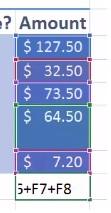How to Use Microsoft Excel 2016 Formulas and Functions
Synopsis: One of the reasons many people fell in love with Excel is its sophisticated formula features. In this article, learn how to correctly type a formula in the Formula Bar. On top of that, get to know some of the commonly used formulas and functions when dealing with calculations in Excel 2016.
One of the greatest strengths of Excel is its ability to provide formulas and functions that always come in handy in situations that call for calculation. In fact, one of the reasons many people fell in love with Excel is its sophisticated formula features.
How Do I Put a Formula in a Cell?
It is important to remember that when putting a formula into a cell, you always begin by typing the Equals sign (=) in the Formula Bar. Then immediately after the Equals sign, without any spaces, continue typing the formula that you want.
For example, let’s say in the given amounts below, you want to get the sum of the amounts in F4 up to F8.
What you are going to do is type the following formula in the Formula Bar:
F4+F5+F6+F7+F8


Need to Learn Excel? Get a Free Excel 2016 Course – Click Here
To get the total of the selected amounts, either press Enter on the keyboard or click the check (ü) mark beside the Formula Bar.
What If I Changed the Value in a Cell?
If you changed a value in any of the cells that is included in the formula, the effect is that the formula stays the same, but the sum will automatically change. The total will either increase or decrease depending on the change you have made.
How About If I Insert a Row?
In the same example, if you insert a row in between the two rows where the cells that are part of the formula are displayed, the result will be a change of formula. What Excel does is it compensates for situations like inserting or deleting rows or columns. In this particular example, the formula has been changed to:
![]()
![]()
Is There Another Formula for Getting the Sum?
Absolutely. If you would rather do away with the task of typing each corresponding cell into the formula, you can do so by using the Sum function in the Ribbon. First, select all the cells with values you want to add, but this time, include the cell where you want the sum to show. Then under the Editing group, click the dropdown menu beside the AutoSum button. Among the options, select Sum. Watch how the cell that corresponds to the total populates with the sum of all the values.
Importantly, notice that in the Formula Bar, a new formula appears. This time, it becomes:
![]()
![]()
How Do I Get the Maximum Amount?
To get the maximum amount among all the values in a column, you will have to change the formula into:
![]()
![]()
When you press Enter or click the check mark, you will then find the maximum value displayed in the appropriate cell.
How Do I Get the Average?
The formula to get the average is as simple as:


There is a myriad of formulas available in Excel 2016, and it pays to know them. So go ahead and explore.

